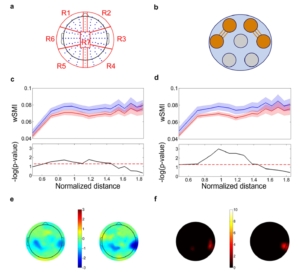Towards affordable biomarkers of frontotemporal dementia: A classification study via network’s information sharing
Scientific Reports
Dottori, M., Sedeño, L., Martorell Caro, M., Alifano, F., Hesse, E., Mikulan, E., García, A. M., Ruiz-Tagle, A., Lillo, P., Slachevsky, A., Serrano, C., Fraiman, D. & Ibáñez, A. (2017). Towards affordable biomarkers of frontotemporal dementia: A classification study via network’s information sharing. Scientific Reports 7, 3822. Online: http://go.nature.com/2tEZwCK.
El desarrollo de biomarcadores masivos y asequibles para las demencias es fundamental dada la dificultad de lograr un diagnóstico temprano. Los métodos de conectividad de electroencefalografía (EEG) ofrecen alternativas prometedoras. En este estudio comparamos la conectividad del estado de reposo en pacientes con demencia frontotemporal (DFT), Alzheimer (AD) y controles. Los pacientes con FTD exhibieron un patrón específico de hipoconectividad frontotemporal, no observado en AD y controles. La combinación de pruebas neuropsicológicas y marcadores de conectividad permitió una clasificación automática robusta de pacientes y controles. La clasificación entre pacientes (DFT vs AD) fue superior cuando se basó en la conectividad cerebral que en las medidas neuropsicológicas. Las medidas de conectividad con EEG podrían representar biomarcadores potenciales de demencia en entornos clínicos
Para acceder al artículo hacé click AQUÍ
Towards affordable biomarkers of frontotemporal dementia: A classification study via network’s information sharing
Scientific Reports
Dottori, M., Sedeño, L., Martorell Caro, M., Alifano, F., Hesse, E., Mikulan, E., García, A. M., Ruiz-Tagle, A., Lillo, P., Slachevsky, A., Serrano, C., Fraiman, D. & Ibáñez, A. (2017). Towards affordable biomarkers of frontotemporal dementia: A classification study via network’s information sharing. Scientific Reports 7, 3822. Online: http://go.nature.com/2tEZwCK.
The development of massive and affordable biomarkers for dementias is critical given the difficulty of achieving an early diagnosis. Electroencephalography (EEG) connectivity methods offer promising alternatives. In this study we compared the connectivity of resting state in patients with frontotemporal dementia (FTD), Alzheimer’s (AD) and controls. Patients with FTD exhibited a specific pattern of frontotemporal hypoconectivity, not observed in AD and controls. The combination of neuropsychological tests and markers of connectivity allowed a robust automatic classification of patients and controls. The classification between patients (DFT vs AD) was superior when based on cerebral connectivity than on neuropsychological measures. Measures of connectivity with EEG could represent potential biomarkers of dementia in clinical settings.
To access the full paper please click here



